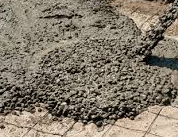Now, we will go through, some of the FAQs regarding the initial and final setting time of cement.
1. What is the initial setting time of cement?
The time period where you can mold the cement mixture at any desired shape without losing its final design strength is called the initial setting time of cement.
 |
| concrete was poured over the slab. |
or in other words,
When cement is mixed with water, from that moment cement starts to set slowly. So, this time period where the cement starts to lose its plasticity and making it hard to pour in the mold or in the formwork is taken as the initial setting time of cement.
For ordinary portland cement, this time period is about 30 min.
2. What is the final setting time of cement?
The time period where the cement, after mixing with water, completely loses its plasticity and has the ability to withstand its shape in the molds or in the formwork with certain rigidity is called the final setting time of cement.
For ordinary portland cement, this time period is about 600 min.
3. What is the importance of the initial setting time of cement?
When the cement is mixed with the water, the hydration process starts and the cement began to harden slowly losing its plasticity. But after mixing concrete, we need some time to carry the concrete and place them in the formwork or any other molds. For most of the work, we can complete this job conveniently within 30 minutes of the time period. While manufacturing the cement, by taking this time period into consideration, certain ingredients were added to provide plasticity to the cement mixtures without losing their design strength.
4. What is the importance of the final setting time of cement?
After pouring the concrete into the formwork or in the molds, the next day, we need the working area to be set, to walk over it, and to keep up the progress in the construction work. The formwork or molds needs to be removed and reused to reduce the working cost and also it becomes necessary to provide regular daily work for the laborers. Keeping it in mind, the convenient time period of 600minutes ( 10 hrs.) is maintained in the regular cement as the final setting time.
5. What are the initial and final setting times of different types of cement?
6. What are the factors that affect the setting time of concrete?
1. Type of cement used.
2. Fineness of the cement.
3. Quantity and quality of the water added.
4. Atmospheric conditions.
5. Addition of the admixtures.
6. Quality and type of sand used.
7. Can we change the initial setting time of cement?
Yes. By adding the admixtures we can change the setting time of the cement. We add chemical retarders to slow the setting rate and an accelerator to speed up the process.
8. How we will test the initial and final setting time of cement?
We can test the setting times of cement using the Vicat apparatus.
 |
| Vicat apparatus. |
From the time when water is added to the cement, and until the time when the needle pierces the test sample is equal to 5.0mm ± 0.5mm. in the Vicat molds, is taken as the initial setting time of that cement.
The time period elapsed from the moment water is added to the cement until the time at which Vicat's annular attachment fails to make an impression over the test samples is taken as the final setting time of that cement.
To go through the comparison & difference between the several types of building materials & construction costs, click here.
Thank you for going through this article❤. Have a good day😄.












No comments:
Post a Comment